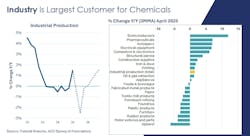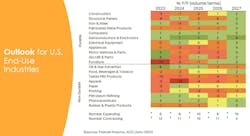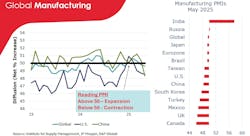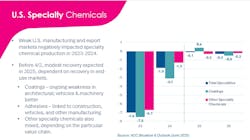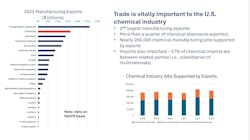Current Outlook of the Chemical Industry: Confused Sea State
State of the Chemical Industry — Three Key Points:
1. Economic Uncertainty from Trade Policy
The economy is in a "confused sea state" due to over 50 tariff announcements creating business planning difficulties. Key dates include July 9 (deadline for reciprocal tariffs) and August 12 (temporary reduction in China tariffs). This uncertainty is cooling U.S. economic growth and putting the Federal Reserve in a difficult position regarding interest rates.
2. Mixed Chemical Industry Performance
While the chemical industry showed strong 6% year-over-year growth in Q1 2025, the outlook is mixed. Basic chemicals are projected to decline 0.4% in 2025 before slight recovery in 2026. Agricultural chemicals are leading with nearly double-digit growth, but consumer products face pressures. The industry benefits from long-term shale gas advantages, maintaining competitive feedstock costs.
3. Critical End-Use Market Challenges
Key chemical markets are under stress — vehicle sales are hampered by $50,000 average new car prices and high interest rates, while housing faces potential $17,000-$22,000 cost increases from building material tariffs. However, semiconductors, aerospace and data center buildout for AI infrastructure are driving growth in certain sectors.
Get your sea legs ready. The economy is getting choppy, according to Martha Gilchrist Moore, chief economist and managing director, economics and statistics at the American Chemistry Council (ACC).
“I'm a sailor. I like to think of this time as sort of a confused sea state,” said Moore on June 10 during a Chemical Processing webinar. “It's a disturbed wave pattern that occurs when multiple wave systems intersect and go in different directions. That's called a confused sea state, and that's a little bit what we've got going on here.”
Moore quickly pointed out the elephant in the room: Uncertainty is cooling the U.S. economy.
She noted that first-quarter GDP growth appeared weak due to import front loading before the April 2 tariff announcements. Excluding trade effects, underlying domestic purchases grew solidly at 2.5% annually. Businesses rushed to import goods in March-April to avoid tariffs, creating inventory buildup that may drag future quarters' growth. Over 50 tariff announcements — new, revised or suspended — have created uncertainty. The inconsistent policy changes, including sectoral tariffs on steel and aluminum with frequent modifications, have made business planning difficult and contributed to slower economic growth.
Moore highlighted a couple of noteworthy dates, starting with July 9, which is the deadline for reciprocal tariffs to take effect barring further delays or failure to reach trade agreements. August 12 is another one to watch. That is the temporary reduction in reciprocal tariffs with China.
The trade war has expanded beyond tariffs to include export controls on critical minerals. China dominates over 90% of rare earths and graphite (used in electric battery anodes), plus significant shares of lithium, nickel and cobalt. China is restricting exports of these materials to the U.S. and other partners. Future import trends remain uncertain pending the expiration of current pauses.
Moore explained that global supply chains are shifting away from China, most significantly affecting electronics, apparel, appliances and consumer goods.
“As these global supply chains get reconfigured, there could be less efficient supply chains that come into effect,” Moore said. “There could be delays in capital expenditure decisions related to where you're going to be producing or moving or processing your materials, and consumers are showing signs of stress.”
Interest Rates Will Remain High
“There had been a lot of progress on inflation in recent months before the tariff announcements,” Moore said. “The April CPI [Consumer Price Index] number actually came in a bit softer than we expected. Those egg prices that everybody has been watching have finally started to come down, and the core price index for personal consumption expenditures has trended down to about 2.7%. But these erratic policy changes have led to tremendous uncertainty, which is stopping growth in the U.S. economy at the same time that tariffs might be raising prices, and this is really putting the Fed in a tough spot.”
U.S. manufacturing grew per the Institute for Supply Management (ISM) purchasing managers index in January and February. Still, it returned to contraction in March, April and May, with new export orders dropping significantly. “It's very difficult to make business decisions about investment when you're not sure what the economy is going to look like in six weeks, six months a year from now,” said Moore.
End-Use Markets
“The news is a little sketchy,” said Moore. “We have seen industrial production tick up during the end of 2024 and into 2025. The chemical industry was riding that wave.”
Looking at 20 individual industries that are significant end-use sectors for the chemical industry and their historic performance over the last several months, Moore pointed out that semiconductors, aerospace, electrical equipment, and pharmaceuticals have been outpacing other sectors and will continue to grow (see Figure 1).
“A lot of that is going into the data centers that is fueling this sort of artificial intelligence, this AI build out. There is a years-long backlog on some of the pieces of equipment that are needed to build out those data centers,” she said.
At the bottom, several industries have been declining in the U.S., including apparel, textile mill products and motor vehicles. “I think that's a seasonal thing that's happening there. And rubber products, a lot of that is tires and it tends to follow the vehicles,” Moore said. She adds that the average price of a new vehicle in the U.S. is about $50,000. In addition, the total cost of ownership (insurance, maintenance and repair) has increased substantially since the pandemic. And then, of course, interest rates.
“Vehicle sales are a huge end-use market for the chemical industry [see Figure 2]. Our analysis shows over $4,000 of chemistry in a typical North American-built vehicle, including 426 lbs. of plastics and composites. So this is a challenging time for businesses in that market. We had a huge surge of sales activity in March and April as consumers tried to beat the tariffs, but the sales fell back.”
Housing is another important end-use market for chemicals. According to Moore, a typical single-family house contains 33,000 pounds of chemistry. Affordability is also a huge constraint in this area.
“We've seen estimates that tariffs on building materials could add $17,000 to $22,000 to the cost to build a single-family house. And there are potential labor issues related to immigration,” Moore said, noting that builders are responding to affordability problems by constructing smaller homes. Remodeling activity has also slowed due to weak existing home sales. Forecasts anticipate a potential uptick in 2026.
Chemical Demand
“We're interested in U.S. manufacturing as a growth driver for chemical manufacturing, but we're also looking at global manufacturing,” Moore said. “The U.S. chemical industry exports about 25%. So, we are selling chemicals to other manufacturing sectors.”
Moore highlighted the United States’ key trading partners and their performance (see figure 3). The Indian manufacturing sector continues to expand, as does Russia, due to wartime production. Countries in contraction include China, Korea, Turkey, Mexico, UK, Mexico and Canada.
Federal Reserve industrial production data shows mixed chemical industry performance. Basic and specialty chemicals, including synthetic materials, improved early in the year with April indicating a potential turning point. Three-month moving averages showed strength in crop protection, coatings, organic chemicals, fertilizers, specialties and consumer products (shampoos, cleaning products). However, plastic materials, resins, and inorganic chemicals contracted year-over-year.
Moore noted that ACC now conducts its own quarterly Economic Sentiment Index, surveying CEOs on whether variables increased, decreased or stayed the same, creating a net rising index from their responses.
First-quarter chemical industry data showed improved company activity (sales, production, output). However, this occurred amid negative demand conditions in U.S. and global markets—while demand improved from fourth-quarter 2024, more companies reported deteriorating customer markets than expanding ones. Production, new orders and inventories all increased quarterly. Six-month outlook sentiment turned sharply negative across variables, possibly reflecting post-tariff announcement concerns. Only input/raw material costs were expected to rise, highlighting inflationary pressures facing the industry.
Moore said the chemical industry outlook shows mixed signals for 2025-2026. Despite strong first-quarter gains with 6% year-over-year growth in chemical output, weakness is expected for the remainder of 2025. Basic chemical volumes are projected to decline 0.4% in 2025 before recovering slightly to 0.2% growth in 2026. Specialty chemicals remain essentially flat both years (see figure 4).
Agricultural chemicals lead 2025 performance with nearly double-digit first-quarter growth. Consumer products (cleaning supplies, personal care) show modest 0.8% growth in 2025 but decline 0.9% in 2026, reflecting consumer spending pressures. Basic chemicals face declines in inorganics and synthetic materials, with slight organic chemical improvements.
Long-term fundamentals remain positive due to shale-gas advantages. “You'll remember shale gas really evolved out of the 2005 hurricanes that sent the price of natural gas soaring, which incentivized these sorts of unconventional techniques in shale gas and shale production. And you can see that that ratio has surged,” Moore said, adding that the oil-to-natural gas price ratio stays well above seven, maintaining U.S. competitive advantages in petrochemical feedstocks compared to Europe and Asia. This has driven historic investment and strong plastic resin exports, including record March exports of 2.4 million metric tons.
According to Moore, trade remains vital to the chemical industry. “We're the second-largest manufacturing exporter. More than a quarter of chemical shipments are exported. And nearly 200,000 chemical manufacturing jobs are supported by exports,” she said. The EU-27 is the largest trading partner, followed by Canada and China. However, 57% of chemical imports occur between related parties, highlighting complex global supply chain integration challenges (see figure 5).
What Keeps Industry Economists Up at Night?
Trade, regulations, supply chain disruptions and geopolitical risks are obvious choices. But Moore pointed out workforce concerns. “I’m concerned a little bit about the pullback of federal funding for research and development activities and how that could possibly impact the U.S. as a hub for research and development.”
Despite all the uncertainty, Moore emphasized that U.S. manufacturing is world-class. “We have abundant energy resources. The U.S. has among the highest labor productivity. We have tremendous infrastructure, both physical and digital — things like 5G and AI and cloud computing. The United States has an advanced manufacturing ecosystem, which includes a robust chemical industry, and we really need to preserve these advantages.
“The new administration has an opportunity to adopt policies that enhance the competitiveness of the U.S. chemical industry, and it can also help make manufacturing grow and thrive here in the United States. We need tax provisions to be aligned with pro-growth targeted improvements to TSCA [Toxic Substances Control Act]. We need to update our transportation policies with smart reforms. We need to embrace advanced recycling as a technology, and we need trade policies that protect and bolster the U.S. chemical industry's trade surplus.” ⊕
About the Author
Traci Purdum
Editor-in-Chief
Traci Purdum, an award-winning business journalist with extensive experience covering manufacturing and management issues, is a graduate of the Kent State University School of Journalism and Mass Communication, Kent, Ohio, and an alumnus of the Wharton Seminar for Business Journalists, Wharton School of Business, University of Pennsylvania, Philadelphia.

